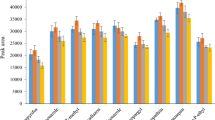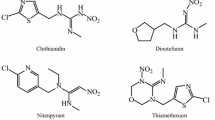Abstract
In this study, a combination of modified quick easy cheap effective rugged and safe extraction and dispersive liquid–liquid microextraction has been proposed for the extraction and preconcentration of some widely used pesticides (diazinon, chlorpyrifos, penconazole, oxadiazon, and diniconazole) from fruit and vegetable samples prior to their determination by gas chromatography–flame ionization detection. In the proposed method, firstly, an aliquot of sample is crushed and then its refuse and juice are separated by centrifuging. The juice is transferred to a conical glass test tube. Then acetonitrile as an extraction/disperser solvent is added into the tube containing the refuse. The analyte residues are extracted into acetonitrile after vortexing. The obtained acetonitrile is mixed with an extraction solvent (1,2–dibromoethane) at microliter level and rapidly injected into the juice. As a result, a cloudy state is formed, and the tiny droplets of the extractant containing the extracted analytes are sedimented at the bottom of the tube after centrifugation. Finally, an aliquot of the sedimented organic phase is removed and injected into the separation system for the quantitative analysis. In this study, several significant factors affecting the performance of the introduced method were investigated and optimized. Under the optimum experimental conditions, enrichment factors ranged from 240 to 375 for apricot nectar and 96–150 for solid samples. The relative standard deviations were ≤ 7% for intra-(n = 6) and inter-day (n = 4) precisions at a concentration of 100 μg L−1 of each analyte. Limits of detection were in the ranges of 0.27–0.48 μg L−1 in the solution and 0.68–1.2 μg kg−1 in the solid samples. Finally, several fruit and vegetable samples were analyzed by the proposed method, and penconazole was found in grape at μg kg−1 level.






Similar content being viewed by others
Abbreviations
- DLLME:
-
Dispersive liquid–liquid microextraction
- EF:
-
Enrichment factor
- ER:
-
Extraction recovery
- GC:
-
Gas chromatography
- LOD:
-
Limit of detection
- LOQ:
-
Limit of quantification
- MS:
-
Mass spectrometry
- QuEChERS:
-
Quick easy cheap effective rugged and safe
- RSD:
-
Relative standard deviation
References
Anastassiades M, Lehotay SJ, Štajnbaher D, Schenck FJ (2003) Fast and easy multiresidue method employing acetonitrile extraction/partitioning and “dispersive solid–phase extraction” for the determination of pesticide residues in produce. J AOAC Int 86:412–431
Cunha S, Fernandes J (2011) Multipesticide residue analysis in maize combining acetonitrile-based extraction with dispersive liquid–liquid microextraction followed by gas chromatography–mass spectrometry. J Chromatogr A 1218:7748–7757
European Commission (2011) Method validation and quality control procedures for pesticide residues analysis in food and feed. Document No SANCO/12495/2011. Retrieved from http://ec.europa.eu/food/plant/protection/pesticides/docs/ qualcontrol_en.pdf. Accessed on 30 July 2018
Farajzadeh MA, Djozan D, Khorram P (2012) Development of a new dispersive liquid–liquid microextraction method in a narrow-bore tube for preconcentration of triazole pesticides from aqueous samples. Anal Chim Acta 713:70–78
Farajzadeh MA, Feriduni B, Mogaddam MRA (2015) Development of counter current salting-out homogenous liquid–liquid extraction for isolation and preconcentration of some pesticides from aqueous samples. Anal Chim Acta 885:122–131
Farajzadeh MA, Mohebbi A, Feriduni B (2016) Development of continuous dispersive liquid–liquid microextraction performed in home-made device for extraction and preconcentration of aryloxyphenoxy–propionate herbicides from aqueous samples followed by gas chromatography–flame ionization detection. Anal Chim Acta 920:1–9
Farajzadeh MA, Mohebbi A, Mogaddam MRA, Davaran M, Norouzi M (2018) Development of salt-induced homogenous liquid–liquid microextraction based on iso-propanol/sodium sulfate system for extraction of some pesticides in fruit juices. Food Anal Methods 11:2497–2507
Kjærstad MB, Taxvig C, Nellemann C, Vinggaard AM, Andersen HR (2010) Endocrine disrupting effects in vitro of conazole antifungals used as pesticides and pharmaceuticals. Reprod Toxicol 30:573–582
Lozano A, Rajski Ł, Belmonte–Valles N, Uclés A, Uclés S, Mezcua M, Fernández–Alba AR (2012) Pesticide analysis in teas and chamomile by liquid chromatography and gas chromatography tandem mass spectrometry using a modified QuEChERS method: validation and pilot survey in real samples. J Chromatogr A 1268:109–122
Mohebbi A, Yaripour S, Farajzadeh MA, Mogaddam MRA (2018) Combination of dispersive solid phase extraction and deep eutectic solvent–based air–assisted liquid–liquid microextraction followed by gas chromatography–mass spectrometry as an efficient analytical method for the quantification of some tricyclic antidepressant drugs in biological fluids. J Chromatogr A Accepted article 1571:84–93. https://doi.org/10.1016/j.chroma.2018.08.022
Navalon A, Prieto A, Araujo L, Vılchez JL (2002) Determination of oxadiazon residues by headspace solid–phase microextraction and gas chromatography–mass spectrometry. J Chromatogr A 946:239–245
Payá P, Anastassiades M, Mack D, Sigalova I, Tasdelen B, Oliva J, Barba A (2007) Analysis of pesticide residues using the quick easy cheap effective rugged and safe (QuEChERS) pesticide multiresidue method in combination with gas and liquid chromatography and tandem mass spectrometric detection. Anal Bioanal Chem 389:1697–1714
Płotka-Wasylka J, Szczepańska N, de la Guardia M, Namieśnik J (2016) Modern trends in solid phase extraction: new sorbent media. Trends Anal Chem 77:23–43
Poulsen ME, Hansen HK, Sloth JJ, Christensen HB, Andersen JH (2007) Survey of pesticide residues in table grapes: determination of processing factors, intake and risk assessment. Food Addit Contam 24:886–895
Ravelo–Pérez LM, Hernández–Borges J, Rodríguez–Delgado MÁ (2008) Multi–walled carbon nanotubes as efficient solid-phase extraction materials of organophosphorus pesticides from apple, grape, orange and pineapple fruit juices. J Chromatogr A 1211:33–42
Rezaee M, Assadi Y, Hosseini M–RM, Aghaee E, Ahmadi F, Berijani S (2006) Determination of organic compounds in water using dispersive liquid–liquid microextraction. J Chromatogr A 1116:1–9
Sarafraz-Yazdi A, Amiri A (2010) Liquid-phase microextraction. Trends Anal Chem 29:1–14
Torbati M, Farajzadeh MA, Torbati M, Nabil AAA, Mohebbi A, Mogaddam MRA (2018) Development of salt and pH–induced solidified floating organic droplets homogeneous liquid–liquid microextraction for extraction of ten pyrethroid insecticides in fresh fruits and fruit juices followed by gas chromatography–mass spectrometry. Talanta 176:565–572
Wang Y, Wang Z, Zhang H, Shi Y, Ren R, Zhang H, Yu Y (2011) Application of pneumatic nebulization single-drop microextraction for the determination of organophosphorous pesticides by gas chromatography–mass spectrometry. J Sep Sci 34:1880–1885
Wu Q, Chang Q, Wu C, Rao H, Zeng X, Wang C, Wang Z (2010) Ultrasound-assisted surfactant-enhanced emulsification microextraction for the determination of carbamate pesticides in water samples by high performance liquid chromatography. J Chromatogr A 1217:1773–1778
Yao Z–w, Jiang G–b, Liu J–m, Cheng W (2001) Application of solid-phase microextraction for the determination of organophosphorous pesticides in aqueous samples by gas chromatography with flame photometric detector. Talanta 55:807–814
Zhang J, Liang Z, Li S, Li Y, Peng B, Zhou W, Gao H (2012) In-situ metathesis reaction combined with ultrasound-assisted ionic liquid dispersive liquid–liquid microextraction method for the determination of phenylurea pesticides in water samples. Talanta 98:145–151
Zhou Q, Bai H, Xie G, Xiao J (2008) Trace determination of organophosphorus pesticides in environmental samples by temperature-controlled ionic liquid dispersive liquid–phase microextraction. J Chromatogr A 1188:148–153
Acknowledgments
The authors thank the Research Council of University of Tabriz for financial support.
Funding
Mir Ali Farajzadeh has received research grants from University of Tabriz.
Author information
Authors and Affiliations
Corresponding author
Ethics declarations
Conflict of Interest
Mir Ali Farajzadeh declares that he has no conflict of interest. Hessamaddin Sohrabi declares that he has no conflict of interest. Ali Mohebbi declares that he has no conflict of interest.
Ethical Approval
This article does not contain any studies with human or animal subjects.
Informed Consent
Not applicable.
Electronic Supplementary Material
ESM 1
(DOC 382 kb)
Rights and permissions
About this article
Cite this article
Farajzadeh, M.A., Sohrabi, H. & Mohebbi, A. Combination of Modified QuEChERS Extraction Method and Dispersive Liquid–Liquid Microextraction as an Efficient Sample Preparation Approach for Extraction and Preconcentration of Pesticides from Fruit and Vegetable Samples. Food Anal. Methods 12, 534–543 (2019). https://doi.org/10.1007/s12161-018-1384-x
Received:
Accepted:
Published:
Issue Date:
DOI: https://doi.org/10.1007/s12161-018-1384-x




